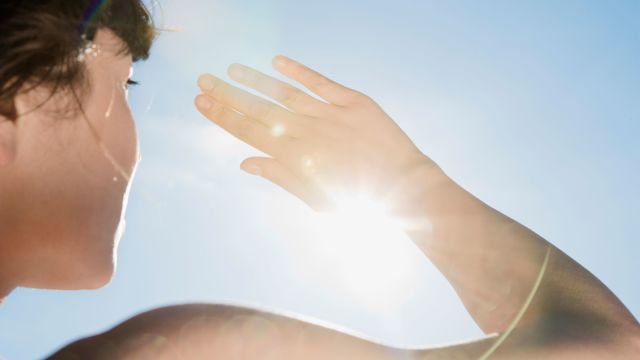Updated on January 2, 2025.
If you use certain medications, you may want to take extra precautions before heading out into the sun. That’s because some drugs may leave you more prone to sunburn, raising your risk of skin cancer.
Since many of these medications are common, and even potentially lifesaving, the solution isn’t to stop taking them. Instead, it’s important to employ some common-sense sun-protection measures to safeguard your skin.
What is photosensitivity?
Photosensitivity is an unusual response to UV rays from the sun or a tanning bed. There are two forms of photosensitivity: photoallergy and phototoxicity.
Photoallergy
A photoallergy, or sun allergy, is an immune response that occurs after you’ve used a medication and have been exposed to sunlight. It’s much more likely to happen with topical medications rather than medications you take internally.
“The sun’s ultraviolet (UV) rays change the structure of the drug, so it’s seen by the immune system as a foreign invader,” explains Jill Stegall, a pharmacist in Waterloo, Iowa. The allergic response usually develops one to three days after taking the drug. It may involve an itchy rash that can have discolored bumps, scaling, and oozing. The outbreak can spread to all parts of the body, not just the areas that were exposed to sun.
Phototoxicity
Phototoxicity is much more common than photoallergy, and occurs when UV rays interact with your medication, causing exposed skin to burn more severely or more quickly than normal—sometimes within just a few minutes. It can also happen later, between 12 and 120 hours after the sun exposure.
“Some of the phototoxic drugs are dose-dependent, so the higher the dose, the more likely you are to have a reaction,” says Stegall.
Sunburn and hydrochlorothiazide
It’s easy to discount the dangers of a sunburn. After all, the pain, swelling, and possibly even blistering usually go away in a few days. But don’t underestimate their impact: Sunburns can do lasting damage to your skin, causing mutations in the DNA of sun-exposed cells that can develop into skin cancer.
At least one drug has even been directly linked with an increase in skin cancer due to its ability to enhance the harmful effects of sunlight. This is the blood pressure medication hydrochlorothiazide. A 2024 systematic review and meta-analysis published in JID Innovations found the risk of developing nonmelanoma skin cancer (the less-risky kind) was 36 percent higher in people who take hydrochlorothiazide.
It’s important to understand, however, that the heart and blood vessel issues treated and potentially prevented by hydrochlorothiazide are far more dangerous than the rise in skin cancer risk. Continue taking all your medications as prescribed, and talk to an HCP if you have concerns about sunburn. In the meantime, you can also take steps to protect yourself from the sun’s harmful rays.
Medications that may react to the sun
There are multiple classes of drugs and about 400 individual drugs that cause photosensitivity. Antibiotics are one of the “worst offenders,” reports Stegall. Here are some of the other medications that may be particularly problematic.
- Acne medications including retinoids and sulfa drugs like sulfamethoxazole/trimethoprim (Bactrim, Septra), and tetracyclines like doxycycline, minocycline, and tetracycline
- Antibiotics including fluoroquinolones like ciprofloxacin (Cipro) and levofloxacin (Levaquin), sulfa drugs, and tetracyclines
- Antidepressants like amitriptyline and St. John’s wort
- Antifungals like voriconazole
- Antihistamines like cyproheptadine, diphenydramine (Benadryl), ranitidine, promethazine, and loratadine (Claritin)
- Antipsychotics like chlorpromazine
- Cholesterol-lowering drugs including statins like atorvastatin, pravastatin, and simvastatin
- Diuretics like furosemide (Lasix) and hydrochlorothiazide
- Heart medications including amiodarone, a drug that regulates your heart rhythm. About 10 percent of people taking it have a reaction to sun.
- Nonsteroidal anti-inflammatory drugs (NSAIDs) like ketoprofen, naproxen, piroxicam, and ibuprofen
- Oral contraceptives and estrogens
- Seizure medications like lamotrigine and carbamazepine
- Type 2 diabetes medications like metformin, glipizide and glyburide
Prescription medicines that are most likely to be photosensitizing may come with a sun sticker, a yellow label bearing an icon of the sun with a slash through it, says Stegall. The fine print of the label will say that you should avoid prolonged or excessive exposure to sunlight while taking the drug.
If you’re not sure if the medications you take may make you more sun-sensitive, check with an HCP or pharmacist. Also keep in mind that any photosensitivity risk may still be present once you have stopped taking the medication.
Who’s at risk
There’s no sure way to know if your medications will react with the sun. Many people who take a photosensitizing medicine don’t experience a reaction. Even if you have an instance of sun sensitivity, it doesn’t mean you’re guaranteed to have another if you continue using the drug.
While these types of reactions can happen to anyone, those who are already more sensitive to the sun—including fair-skinned people with light-colored eyes—are more prone to experiencing one.
Protect your skin
If you take these medicines, it’s crucial to be especially diligent about protecting yourself from UV exposure every day, year-round—not just when you’re having fun in the sun. While you’re likely to spend more time outside in the summer, many medications mainly react with UVA rays, which are present with relatively equal intensity during daylight hours throughout the year. And you don’t have to be at the beach or the pool, or even outside, to experience a reaction.
“I’ve even seen it happen to someone driving in a car,” says Stegall. That’s because the side and rear windows in a car aren’t specially treated the same way the windshield is to prevent UVA rays from penetrating. To fix this, you can purchase UV window film.
Salon tanners should take note, too. Exposure to the UVA light used in tanning beds can also trigger these reactions.
To keep from having a reaction to the sun, try these tips:
- Avoid prolonged exposure to sunlight, especially between the high-intensity hours of 10 a.m. and 2 p.m.
- Wear sun-protective clothing, including wide-brimmed hats, sunglasses, and long-sleeved shirts and pants made of tightly woven fabric.
- Apply a broad-spectrum sunscreen (meaning it protects against both UVA and UVB) of at least SPF 30 or higher to all exposed skin every day. Be sure to reapply every two hours or more if you’re swimming or sweating—even if you’re using water-resistant sunscreen.
If you still experience a photosensitivity reaction despite taking these precautions, don’t stop taking the drug without talking to your HCP first. “Avoid any more sun exposure and consult with your doctor, who may reduce the dose or switch you to a different medication,” says Stegall.







